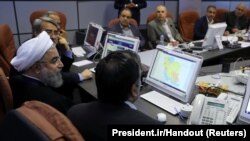A few days before voters went to polls, the Rouhani government published a 255-page plan, labeled Iran Again, which deals with all sorts of problems the country faces. But what this document says and does not say about the economy is revealing. Iran’s economic future, to a large extent, depends on a change of course in foreign policy.
In the introductory part of the plan, Rouhani’s government addresses the country’s economic failures and concludes that Iran “needs a technologically advanced economy, which is modern and compatible with environmental standards, but unfortunately we have failed to achieve this goal in the past century. We had progress in many areas, but the truth is we are still far from becoming a regional or an international economic power.”
The authors of the plan describe that in the past three decades, Iran’s economy has faced low growth and numerous boom and bust cycles. The bottom line is that the economy is both dependent on oil, in terms of income, and is also an “inward-looking” economy, unable to export a lot of non-oil products. The result is that Iran cannot achieve stable growth and generate enough jobs.
The solution lies in many structural changes, according to the Rouhani plan. But until achieving long-term goals, the government needs to deal with urgent problems: poverty, unemployment, deficit in pension funds, a decline in the quality and quantity of government services, and a big disparity among different provinces, among others. The plan sets out to come up with short-term solutions and setting the stage for long-term structural reforms.
The newly re-elected president was the only candidate among five others to even attempt to present a comprehensive economic plan. But how good is this plan?
The plan has identified a lot of fundamental issues, and many of the solutions it proposes are realistic. We can say that this is a plan that, after four decades of trial and error, has been a long time in the making. The plan is worth reading for anyone who are interested in the Iranian economy or developing economies.
Avoiding the Red Lines
Nevertheless, the authors of the plan have steered clear of addressing some fundamental issues that have put the country at an economic dead-end. They did not have much of a choice. Iran has many un-written red lines that everyone is well aware of and has to take into account.
Here we will address two such instances.
A considerable part of the Iranian economy is under the monopoly of institutions that according to Rouhani “are outside the circle of accountability” and the government has no control over them. It is well known that in Iran there are hundreds of industrial, business, and financial enterprises that are controlled by religious and military institutions. These are huge economic empires by Iranian standards, such as the Revolutionary Guards’ Khatam al-Anbia economic branch or huge religious “nonprofit charities.” Their real share in Iran’s economy and their impact on economic fundamentals, such as inflation, unemployment, and foreign trade, however, are hard to say.
In the Rouhani plan, the authors complain that these institutions “are not accountable to anyone and some do not even pay taxes. To achieve economic development and solve a lot of problems depends on everyone being accountable and equal in front of the law.”
What are the solutions? Who profits from this “gray zone” of Iran’s economy at the expense of all citizens? What are the dimensions of this sector? Ordinary people ask these questions, and it is one of the main reasons for their lack of trust in the regime, which the government plan mentions. “Studies of social attitudes show that public trust of people toward each other, toward official state organs, and toward the political system has seriously eroded.”
Nevertheless, the government plan does not propose a clear or specific solution, because this is one of the big red lines for the regime.
The Rouhani plan also fails to deal with another serious hurdle for the economy: Iran’s foreign policy. One of the serious reasons for the decline of Iran’s post-revolution economy is its tension-generating foreign policy. This serious problem became much worse during Iran’s nuclear issue, which led to stringent international sanctions.
The Rouhani plan mentions the consequences. “In 2013, the country was on the verge of bankruptcy, and if oil exports had completely stopped the government would have faced serious problems in dealing with the basic needs of the population. Inflation would rise at an unprecedented pace and the national currency would plunge fourfold. If this scenario had happened, there would be no need for a military attack by the enemy; the country would reach disintegration from within.”
What is the solution? Is it possible to have “mutually beneficial interaction” (Ta’amol in Persian) with the world, when “Death to America” and “Death to Israel” are the foundations of foreign policy -- and are pursued with interventions in Syria, Iraq, Lebanon, and Yemen? Is it possible to attract foreign investment and still have a self-sustaining economy? Can we imagine that in Rouhani’s second term foreign policy will be transferred from the supreme leader to Rouhani’s government?
We cannot avoid these questions. In Iran, as in other countries, a tension-generating foreign policy can derail the best economic plan, even one devised by geniuses.






